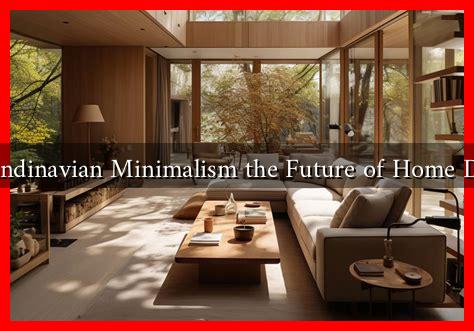-
Table of Contents
Is Scandinavian Minimalism the Future of Home Design?
In recent years, Scandinavian minimalism has emerged as a dominant trend in home design, captivating homeowners and designers alike with its clean lines, functional aesthetics, and emphasis on simplicity. But is this design philosophy merely a passing fad, or does it represent the future of home design? This article explores the principles of Scandinavian minimalism, its impact on modern living, and why it may be the blueprint for future homes.
Understanding Scandinavian Minimalism
Scandinavian minimalism is rooted in the design philosophies of the Nordic countries—Denmark, Sweden, Norway, Finland, and Iceland. It emphasizes functionality, simplicity, and a connection to nature. Key characteristics include:
- Neutral Color Palettes: Whites, grays, and muted tones dominate, creating a serene environment.
- Natural Materials: Wood, stone, and textiles are commonly used, promoting sustainability and warmth.
- Functional Furniture: Pieces are designed for utility without sacrificing style, often featuring multi-functional capabilities.
- Open Spaces: Layouts prioritize light and airiness, encouraging a sense of freedom and tranquility.
The Rise of Minimalism in Modern Living
As urban living spaces become smaller and more expensive, the appeal of Scandinavian minimalism grows. According to a report by the National Association of Realtors, 43% of homebuyers prioritize open floor plans, which align perfectly with minimalist design principles. The trend is not just about aesthetics; it reflects a broader cultural shift towards simplicity and sustainability.
Case Study: The Tiny House Movement
The tiny house movement exemplifies the principles of Scandinavian minimalism. These compact homes, often under 400 square feet, focus on efficient use of space and resources. For instance, the Tiny House Company has seen a surge in interest, with many opting for minimalist designs that incorporate multifunctional furniture and sustainable materials. This movement highlights how minimalism can lead to a more sustainable lifestyle, reducing waste and energy consumption.
Benefits of Scandinavian Minimalism
Adopting Scandinavian minimalism in home design offers numerous benefits:
- Enhanced Well-being: A clutter-free environment can reduce stress and promote mental clarity.
- Increased Functionality: Thoughtfully designed spaces maximize utility, making daily tasks easier.
- Sustainability: Emphasizing natural materials and energy-efficient designs contributes to environmental conservation.
- Timeless Aesthetic: The simplicity of Scandinavian design ensures that it remains stylish and relevant over time.
Challenges and Criticisms
Despite its many advantages, Scandinavian minimalism is not without its challenges. Critics argue that:
- It Can Feel Cold: The emphasis on minimalism may lead to spaces that feel sterile or uninviting.
- Cost of Materials: High-quality natural materials can be expensive, making it less accessible for some homeowners.
- Over-Simplification: Some believe that minimalism can oversimplify the complexities of personal expression in home design.
The Future of Home Design
As we look to the future, the principles of Scandinavian minimalism are likely to influence home design significantly. With a growing emphasis on sustainability and wellness, homeowners are increasingly seeking designs that reflect these values. According to a survey by the American Institute of Architects, 62% of architects reported a growing interest in sustainable design practices, which aligns closely with the tenets of Scandinavian minimalism.
Conclusion: A Blueprint for Tomorrow
In conclusion, Scandinavian minimalism is more than just a design trend; it represents a shift towards a more sustainable, functional, and aesthetically pleasing way of living. As urbanization continues and environmental concerns grow, the principles of this design philosophy may very well shape the future of home design. By embracing simplicity and functionality, homeowners can create spaces that not only look good but also enhance their quality of life. The future of home design may indeed be Scandinavian, offering a harmonious blend of beauty, utility, and sustainability.


